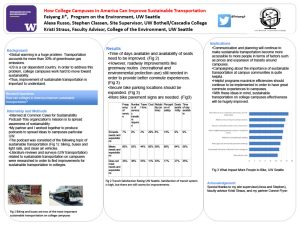How College Campuses in North America can Improve Sustainable Transportations
Global warming is a huge problem in the globe, and the US is no exception. Transportation emissions account for more than 30% of greenhouse gas emissions. If sustainable transportations are not addressed, emissions will continue to happen and factors such as congestion will continue to exist. The aim of this study was to explore students/faculties preferences of transportation on North America college campuses in order to know the current trend and room of improvement for sustainable transportation. To accomplish this task, I interviewed different fields of experts like biking clubs to explore the status quo of students’ and faculties’ habits on taking transportations. The trends will help to determine ways to improve sustainable transportation such as incentives, more sustainable transportations being available, etc. For instance, findings show that UW Seattle employees, particularly students, generally support sustainable transportation and biking facilities, and many college campuses in America show similar trends. These positive results suggest efforts on college campuses have been made toward sustainable transportations. However, factors such as roads and building designs still need to improve to provide convenience of sustainable transportation and improve awareness about this topic. Thus, communications and planning are imperative to make sustainable transportations become more accessible to more people in terms of factors such as prices and expansion of transits around campuses. Awareness (eg. Students participation in transportation initiative) is also important in improving transportations. Finally, existing helpful programs like Transportation Demand Management should continue to be implemented to ensure effectiveness of commutes on campus.
